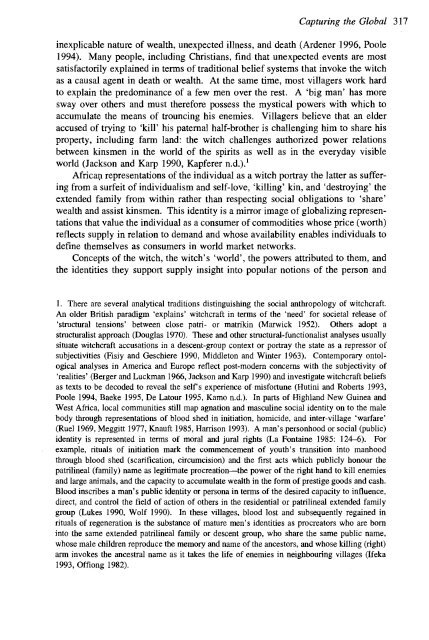godfrey lienhardt - Institute of Social and Cultural Anthropology ...
godfrey lienhardt - Institute of Social and Cultural Anthropology ...
godfrey lienhardt - Institute of Social and Cultural Anthropology ...
Create successful ePaper yourself
Turn your PDF publications into a flip-book with our unique Google optimized e-Paper software.
Capturing the Global 317<br />
inexplicable nature <strong>of</strong> wealth, unexpected illness, <strong>and</strong> death (Ardener 1996, Poole<br />
1994). Many people, including Christians, find that unexpected events are most<br />
satisfactorily explained in terms <strong>of</strong> traditional belief systems that invoke the witch<br />
as a causal agent in death or wealth. At the same time, most villagers work hard<br />
to explain the predominance <strong>of</strong> a few men over the rest. A 'big man' has more<br />
sway over others <strong>and</strong> must therefore possess the mystical powers with which to<br />
accumulate the means <strong>of</strong> trouncing his enemies. Villagers believe that an elder<br />
accused <strong>of</strong> trying to 'kill' his paternal half-brother is challenging him to share his<br />
property, including farm l<strong>and</strong>: the witch challenges authorized power relations<br />
between kinsmen in the world <strong>of</strong> the spirits as well as in the everyday visible<br />
world (Jackson <strong>and</strong> Karp 1990, Kapferer n.d.).l<br />
AfricaQ representations <strong>of</strong> the individual as a witch portray the latter as suffering<br />
from a surfeit <strong>of</strong> individualism <strong>and</strong> self-love, 'killing' kin, <strong>and</strong> 'destroying' the<br />
extended family from within rather than respecting social obligations to 'share'<br />
wealth <strong>and</strong> assist kinsmen. This identity is a mirror image <strong>of</strong> globalizing representations<br />
that value the individual as a consumer <strong>of</strong> commodities whose price (worth)<br />
reflects supply in relation to dem<strong>and</strong> <strong>and</strong> whose availability enables individuals to<br />
define themselves as consumers in world market networks.<br />
Concepts <strong>of</strong> the witch, the witch's 'world', the powers attributed to them, <strong>and</strong><br />
the identities they support supply insight into popular notions <strong>of</strong> the person <strong>and</strong><br />
1. There are several analytical traditions distinguishing the social anthropology <strong>of</strong> witchcraft.<br />
An older British paradigm 'explains' witchcraft in terms <strong>of</strong> the 'need' for societal release <strong>of</strong><br />
'structural tensions' between close patri- or matrikin (Marwick 1952). Others adopt a<br />
structuralist approach (Douglas 1970). These <strong>and</strong> other structural-functionalist analyses usually<br />
situate witchcraft accusations in a descent-group context or portray the state as a repressor <strong>of</strong><br />
subjectivities (Fisiy <strong>and</strong> Geschiere 1990, Middleton <strong>and</strong> Winter 1963). Contemporary ontological<br />
analyses in America <strong>and</strong> Europe reflect post-modem concerns with the subjectivity <strong>of</strong><br />
'realities' (Berger <strong>and</strong> Luckman 1966, lackson <strong>and</strong> Karp 1990) <strong>and</strong> investigate witchcraft beliefs<br />
as texts to be decoded to reveal the self s experience <strong>of</strong> misfortune (Hutini <strong>and</strong> Roberts 1993,<br />
Poole 1994, Baeke 1995, De Latour 1995, Kamo n.d.). In parts <strong>of</strong> Highl<strong>and</strong> New Guinea <strong>and</strong><br />
West Africa, local communities still map agnation <strong>and</strong> masculine social identity on to the male<br />
body through representations <strong>of</strong> blood shed in initiation, homicide, <strong>and</strong> inter-village 'warfare'<br />
(RueI1969, Meggitt 1977, Knauft 1985, Harrison 1993). A man's personhood or social (public)<br />
identity is represented in terms <strong>of</strong> moral <strong>and</strong> jural rights (La Fontaine 1985: 124-6). For<br />
example, rituals <strong>of</strong> initiation mark the commencement <strong>of</strong> youth's transition into manhood<br />
through blood shed (scarification, circumcision) <strong>and</strong> the first acts which publicly honour the<br />
patrilineal (family) name as legitimate procreation-the power <strong>of</strong> the right h<strong>and</strong> to kill enemies<br />
<strong>and</strong> large animals, <strong>and</strong> the capacity to accumulate wealth in the form <strong>of</strong> prestige goods <strong>and</strong> cash.<br />
Blood inscribes a man's public identity or persona in terms <strong>of</strong> the desired capacity to influence,<br />
direct, <strong>and</strong> control the field <strong>of</strong> action <strong>of</strong> others in the residential or patrilineal extended family<br />
group (Lukes 1990, Wolf 1990). In these villages, blood lost <strong>and</strong> subsequently regained in<br />
rituals <strong>of</strong> regeneration is the substance <strong>of</strong> mature men's identities as procreators who are born<br />
into the same extended patrilineal family or descent group, who share the same public name,<br />
whose male children reproduce the memory <strong>and</strong> name <strong>of</strong> the ancestors, <strong>and</strong> whose killing (right)<br />
arm invokes the ancestral name as it takes the life <strong>of</strong> enemies in neighbouring villages (lfeka<br />
1993, Offiong 1982).
















